Squatted City

Students: Kai Franz, Caroline Pachoud
Location: Group work in Havana
Date: June, 2007
Type: Research project, student work, squatted city
Due to a huge emigration of rich wealthy people after the revolution, notably to Miami, the city of Havana in its found, given volume was resettled and re-inhabited, or metaphorically speaking squatted after 1959. The term squatting is not entirely precise, as the exchange of population was more proactive and under governmental control. Large building structures such as villas were subdivided into multi-family houses. Over the years, this process generated its own selfdynamic: due to the lack of new dwellings vertical and horizontal subdivision of existing buildings provoked smaller and smaller living units. This phenomenon is called barbacoa and can be found across Havana.
Huge informal belts - barrios, but also extreme social segregation with gated communities, are today a burden to every Latin American capital. In Havana this is not the case; it is a contained situation where informality is generated for an entirely different set of reasons. Havana is the only Latin American capital with decreasing population, due to the policy of decentralization and ‘countering Havana’ after 1959. Informality is not a product of huge influx of people into the city, but rather of internal growth of families without possibilities to build and expand, of impossibility to easily trade of exchange the property and also the persistent deterioration of built structure and infrastructures for nearly 50 years. Migrations from countryside into Havana are not free; they are conditioned. A proof has to be submitted that the migrant would have a minimum of 10m2 of personal living space. A citizen of Havana who is willing to provide living space for the newcomer can give such proof.
Housing market doesn’t exist in Cuba, making it difficult to trade or exchange a house. One can sell his house – to the state, at prices that are kept controlled. In recent years and under new economical conditions this policy has produced a reaction - an informal market for housing exchange.
In a city that exists already for 50 years without change in its physical structure, but with acute deterioration and lack of resources for maintenance, the main focus of this study are informal techniques developed to overcome this situation, a myriad of ‘ways to survive’ and adapt space to ones needs.
Download the Book 1 PDF
Download the Book 2 PDF

